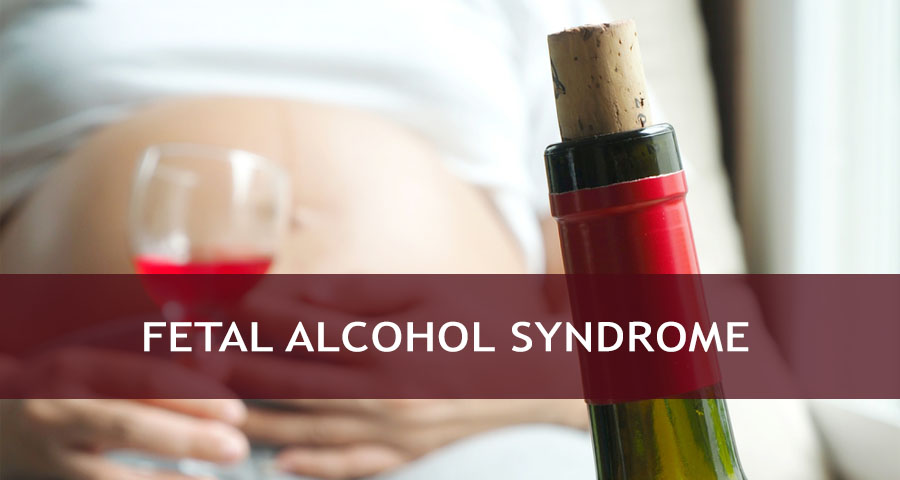
Alcohol and pregnancy are some of the most precarious cases, especially for women suffering from alcoholism. No matter a person’s gender, alcoholism is defined by certain chronic, harmful changes in the function of the brain. However, for several reasons, a woman can develop this condition’s symptoms when consuming much fewer drinks than a man.
Table Of Contents:
- What is the Prevalence of Women Alcohol Consumption?
- What are the Risks and Effects of Alcoholism in Women?
- What are Some Alcohol and Pregnancy Facts?
- What is Fetal Alcohol Syndrome (FAS)?
- How Does One Recognize Fetal Alcohol Syndrome?
- What are the Long-term Consequences of FAS?
- How to Treat Children with FAS?
- How to Prevent This Syndrome?
- When Does Drinking Affect Pregnancy?
- How to Stop Drinking During Pregnancy?

Women that drink heavily and regularly expose themselves to physical problems that are often less common in men due to anatomical differences or occur only in women. For these reasons, alcoholism in women poses a unique, gender-specific threat to health and well-being, especially if alcoholism happens during pregnancy. Alcohol during pregnancy may lead to several fetal alcohol spectrum disorders. Fetal alcohol syndrome (FAS) is one of the most dangerous conditions that can harm newborns. Read further to find out how alcohol and pregnancy can affect women’s health and baby’s life.
When a pregnant woman drinks, it doesn’t affect only her health but also all the fetus’s developing organs, and alcohol stays in the baby’s body much longer.
Women and Alcohol Consumption: The Statistics
Women in the U.S. don’t drink alcohol as often as men. Recent figures from the National Institute on Alcohol Abuse and Alcoholism (NIAAA) indicate that roughly half of all adult females (51 percent) drink in any given month. In contrast, NIAA figures place monthly consumption among men aged 18 and above at just over 59% percent of the population. Women also have a lower participation rate in two dangerous patterns of alcohol intake: Heavy drinking and binge drinking.
Heavy drinking occurs whenever a person’s daily or weekly alcohol consumption exceeds established guidelines for moderate, relatively safe intake. Binge drinking occurs whenever a person consumes enough alcohol within a two-hour window to reach a state of legal drunkenness. In the U.S., heavy-drinking male adults outnumber heavy-drinking female adults by approximately two to one (8.3 percent of the population vs. 4.5 percent). While about 29.7% of males 18 years and older binge drink, just 22.2 percent of adult females engage in this practice.
Finally, women have a lesser chance of being diagnosed with alcohol use disorder or AUD (a condition that includes alcoholism and non-addicted alcohol abuse)—the AUD rate for men 12 years and older hovers around 6.8 percent. In contrast, only about 3.9 percent of women are diagnosed with this condition.

Risks and Effects of Alcoholism in Women
A woman can qualify as a heavy drinker while consuming much less EToH than a man. This is partly because women tend to weigh less than men.
However, There Are Other Reasons, Including:
- The fact that women’s bodies contain smaller amounts of water than men’s bodies
- The fact that a woman starts to show signs of alcohol-related harm much earlier than a man
Water content plays an essential role because EToH tends to accumulate in body fluids. A lower water level translates into faster intoxication and quicker intoxication, as well as the impairment of normal body functions.
Any alcoholic woman can develop two serious health problems, also found in alcoholic men: heart disease and liver damage. However, compared to men, women have higher odds of developing an alcohol-related heart malfunction. They also have higher odds of developing the damaging, potentially fatal liver inflammation known as alcoholic hepatitis. Even when not drinking enough to boost alcoholism risks, a woman who consumes alcohol can elevate her breast cancer risks.
Also, regardless of an alcoholism diagnosis, any woman who drinks heavily during pregnancy puts her developing child at-risk for fetal alcohol syndrome and other fetal alcohol spectrum disorders.
Alcohol and Pregnancy Facts
Ethanol is one of the many substances that can have a severe, negative impact on fetal development. When a pregnant woman drinks, it affects not only her but also all the fetus’s developing organs, and it stays in the baby’s body much longer.
For this reason, there is no safe amount a woman can drink during her pregnancy. Any amount of EtOH can reach the baby through the placenta and cause serious harm.
Drinking alcohol during pregnancy is associated with fetal alcohol spectrum disorders (FASDs), a group of irreversible diseases that cause physical abnormalities and impair mental, functional, psychological, behavioral, and cognitive development in the baby.
According to the Centers for Disease Control and Prevention (CDC), drinking while pregnant can adversely affect the baby’s physical and mental growth and development. Though many women know drinking while pregnant is not a good idea, many still drink and even binge drink during this crucial developmental period. The CDC Behavioral Risk Factor Surveillance System study Found That:
- About 1 in 9 pregnant women reported drinking during the past month.
- About 1/3 of pregnant women reported binge drinking during the past month.
- Pregnant women who indulged in binge drinking during the previous month reported an average of 4.0 percent.
- Among pregnant women, those aged between 35 and 44 years and who were college graduates reported the highest instances of alcohol use.
The statistics on FASDs show that many children are affected by drinking. According to the CDC, one to 5 out of 100 school-aged children in the United States have a form of FASD. About six to nine out of 1,000 school-aged children in the U.S. are afflicted with fetal alcohol syndrome (FAS), the most severe type of FASD. Drinking alcohol during pregnancy is the only cause of FASDs in children.
In Addition to FASDs, there are Other Dangers of Alcohol and Pregnancy:
- Mental impairment
- Physical birth defects
- Miscarriage
- Premature birth
- Stillbirth
- Low birth weight
- Sudden Infant Death Syndrome (SIDS)

What is Fetal Alcohol Syndrome (FAS)?
Drinking while pregnant may lead to a child being born with one of several fetal alcohol spectrum disorders. This term includes a variety of diseases, the symptoms of which can range in severity.
Some of Them Can Lead to Mental or Physical Congenital Disabilities. FASDs Include:
- Fetal alcohol syndrome (FAS)
- Partial FAS
- Alcohol-related congenital disabilities
- Alcohol-related neurodevelopmental disorder
- A neurobehavioral disorder associated with prenatal alcohol exposure
FAS is one of the most severe conditions associated with alcohol and pregnancy. Though the symptoms and defects will vary from person to person, they are often permanent.
Fetal alcohol syndrome symptoms occur due to a deficiency in an infant’s developmental aspects caused by exposure to alcohol in utero. Drinks consumed by the mother during pregnancy can cross the placental barrier and accumulate in the baby’s blood. It stays there longer than in an adult because the fetus is unable to process alcohol as quickly. This can cause damage to the developing organs and lead to issues associated with mild to severe fetal alcohol syndrome.
FAS is the leading preventable cause of birth defects and neurological and developmental disabilities in the U.S. There are six to nine cases of Fetal alcohol syndrome symptoms per 1,000 births.
There are troubling FAS statistics regarding how women drink during pregnancy. According to the Centers for Disease Control and Prevention (CDC) findings, one in ten pregnant women reported drinking, and one in 33 reported binge drinking during the past month. In the same study, pregnant women reported binge drinking an average of 4.6 times during the past month.
Alcohol exposure often occurs within the first few weeks of a pregnancy when a woman may not realize she is pregnant. Though most studies show alcohol is most harmful within the first three months of pregnancy, The American Academy of Pediatrics has stated that consuming alcohol at any point during pregnancy can be detrimental.
How to Recognize Fetal Alcohol Syndrome Symptoms
Growth delays are typical signs of fetal alcohol syndrome, although these delays may have other causes. Birth weight in the 10th percentile or lower is common with fetal alcohol syndrome symptoms. The same can be said for delayed growth in other measurements, such as length and head circumference.
Babies with FAS May Also Have Abnormal Physical Features:
- The smooth ridge between the nose and upper lip
- Thin upper lip
- Flattened cheeks
- Small jaws
- Wide-spaced eyes
- Drooping eyelids
- Microcephaly (small head and brain)
- Heart problems
- Spine, kidney, and liver disease
- Structural differences in the brain as evident from CT scans or MRIs
According to the Institute of Medicine, out of all substances of abuse, alcohol produces the most severe form of neurobehavioral effects in the fetus.
Alcohol exposure in utero impairs the normal development of the central nervous system (CNS), made up of the brain and the spinal cord.

The Long-Term Consequences of FAS
This condition has no cure, and fetal alcohol syndrome in adults is a reality. While interventions and treatments can help, especially when begun early, many children with FAS will develop long-term challenges and struggle with ongoing consequences that follow them into adulthood:
- Cognitive deficiency. This includes a low IQ that manifests as difficulty learning and following instructions and slow reactions. Children with FAS often perform poorly in school.
- Impaired motor functionality. Children who display Fetal alcohol syndrome symptoms also have impaired muscle coordination, delays in developing gross motor skills like rolling over, crawling, sitting up, and walking, and delayed fine motor skills like grasping objects, writing, and drawing. They may exhibit balance problems or be clumsy. As infants, these children may have had difficulties sucking.
- Executive functioning difficulty. These deficiencies include poor organization and planning, poor impulse control, inability to understand and follow multi-step instructions, poor judgment, inability to comprehend cause-effect relationships, poor language comprehension, and impaired memory skills.
- Attention problems or hyperactivity. Like hyperactive behaviors and difficulty focusing, symptoms similar to those caused by attention deficit hyperactivity disorder (ADHD) are possible with FAS.
- Problems with social skills. Children with FAS may show a lack of empathy, an unusual lack of fear of strangers that is normal in children, and immaturity. When older, they may also exhibit inappropriate sexual behaviors.
- Trouble with the law. Poor impulse control, poor judgment, inability to understand cause-effect relationships, and difficulty controlling emotions can cause someone with FAS to be more prone to violence or non-violent crimes.
Substance use disorders. One of the effects of fetal alcohol syndrome is a greater risk of developing substance use disorders.
The sooner FAS can be diagnosed, the better a child’s outcome is likely to be.
Diagnosing FAS
It is vital to have a child evaluated if signs of FAS are seen, and mothers must be honest about drinking while pregnant to make an accurate diagnosis.
To make a diagnosis, a doctor needs to know about maternal drinking while pregnant and then observe a child as he or she grows to look for FAS signs.
The Three Main FAS Characteristics that a Doctor Will Look For Are:
- Typical FAS facial features
- Delays in growth, development, and motor skills
- Central nervous system problems that may manifest as behavioral or physical issues

Treating Children with FAS
The symptoms and long-term consequences of fetal alcohol syndrome in adults can be severe. But a baby with FAS is not necessarily doomed. With early diagnosis and treatment interventions, these children can learn to manage symptoms.
While there is no cure for fetal alcohol syndrome in adults, early interventions can improve developmental difficulties and minimize the long-term challenges of this condition. Treatments and interventions include behavioral therapies, educational interventions, and medications that evolve as a child grows and develops.
The Prognosis for FAS Improves Dramatically if:
- The condition is diagnosed before a child is six
- Treatment and therapy start as early as possible
- The child is brought up in a loving, stable, and violence-free home
- The child benefits from social services and special education services
The environment that children with FAS grow up in is essential to outcomes. These children are more likely to develop substance abuse problems as well as behavioral issues later in life. This risk is heightened if exposed to substance use, violence, or instability in the home. They benefit from caring parents, reward systems for positive behavior, simple rules, and a clear and comfortable routine. Children with FAS are more sensitive to change and disruption in their routine, so stability is crucial for supporting development.
Medications
Though some medications address fetal alcohol syndrome symptoms, there is no medication to treat the syndrome itself. Although, medicines that may help include:
- Antidepressants
- Stimulants to help with focus and behavioral problems
- Neuroleptics to help with anxiety and violent tendencies
- Anti-anxiety drugs
Do not take any medications without consulting a doctor. Unmonitored treatment can damage both mother and baby.
Early interventions are essential for managing symptoms, complications, and characteristics of fetal alcohol syndrome.
Behavioral and Educational Interventions
Interventions and treatments for children with FAS include:
- Speech and language therapy
- Physical therapy
- Education for parents
- Behavioral therapy
- Psychotherapy
- Educational intervention
- Social skills training
Therapies, like cognitive behavioral therapy, can help a child learn to manage and control emotions and problem behaviors. Behavioral and social therapies help children learn how to get along with and socialize appropriately with peers. Speech and physical therapies can also help correct language or motor difficulties.
Educational interventions through a child’s special education services are also crucial. These can diagnose learning disabilities and cognitive defects and implement services that will help a child thrive and succeed in spite of them. As a child gets older, vocational and life skills training may be important. Early interventions, such as special education services, can help a child catch up, but there is no cure or way to reverse the damage caused by FAS.

Preventing Fetal Alcohol Syndrome
Of all the FAS facts, the most important is that the only way to prevent fetal alcohol syndrome is to avoid consuming any alcoholic beverages during pregnancy. Even a single drink can be dangerous to the developing organs of the baby. Women who are trying to get pregnant should stop drinking immediately, as any drinking during the early phases of pregnancy can be dangerous.
Any woman planning to become pregnant should be cautious about drinking, and any existing drinking problems should be addressed. Treatment can help a woman stop drinking so that she can safely get pregnant.
FAS sets a child up for a life of challenges and adversities. Prenatal exposure to drinking causes damage that can trigger problems with development, motor skills, growth, cognition, emotional and behavioral regulation, and mental health. Fortunately, early diagnosis and prompt interventional treatment can manage and even reverse some symptoms and help a child learn the life skills necessary to function independently in life and reach full potential.
Other Fetal Alcohol Spectrum Disorders
In addition to fetal alcohol syndrome, drinking alcohol during pregnancy can cause different types of FASDs, such as alcohol-related neurodevelopmental disorder (ARND). It causes neurodevelopmental issues, problems with self-regulation and adaptive skills, as well as behavioral problems. Issues with intellectual development can cause children with ARND to perform poorly in school.
Alcohol-related congenital disabilities, or ARBD, are a group of congenital physical disabilities caused by alcohol. These may include:
- Kidney issues
- Heart problems
- Ear and eye malformations
- Skeletal defects
- Hearing difficulties
According to the National Institutes of Health, alcohol is most harmful to the baby during the first three months of pregnancy.
When Does Alcohol Affect Pregnancy?
Just as there is no safe amount of alcohol, there is no safe time to drink during pregnancy. However, during some periods, drinking can do more harm than in others.
Drinking During the First Trimester
How early does alcohol affect a baby? According to the National Institutes of Health, alcohol is most harmful to the baby during the first three months of pregnancy. The baby’s facial features, anatomical structures, and brain and spinal cord develop during this period.
An Increase in Ethanol Consumption by One Drink Per Day During the First Trimester of Pregnancy Causes:
- A 25 percent increase in the chance of the baby being born with abnormal facial features, like a smooth ridge between the nose and the upper lip and narrow eye openings.
- A 12 percent more likelihood of the baby having a smaller-than-average head.
- A 16 percent increase in the chance of the baby having a low birthweight.
- An increased risk of neurological abnormalities, a development that is usually associated with the presence of facial abnormalities.
- An increased risk of damage to the brain circuitry and loss of certain types of nerve cells, according to the National Institute on Alcohol Abuse and Alcoholism.
According to researchers at the University of California, San Diego, the developing fetus is harmed the most when the mother drinks during the second half of the first trimester.
Drinking During the Second Trimester
There seems to be a popular false belief that drinking alcohol while pregnant is safe after the first trimester. But researchers warn that the baby’s brain and spinal cord develop throughout pregnancy, so liquor consumption at any stage can harm the baby. According to theNational Organization on Fetal Alcohol Syndrome, prenatal exposure to drinking can cause severe neurological defects in the child.
Drinking alcohol during the second trimester of pregnancy leads to:
- A 68 percent increase in the risk of the baby being born smaller than average.
- An increased risk of complications like abnormal brain development, breathing trouble, and difficulty regulating body temperature.
- An increased risk of neurological abnormalities.
Drinking During the Third Trimester
It is not even safe to drink during the third trimester. During this period, alcohol will only increase the risk of premature delivery and the risk of other complications. In addition to the continuing development of the brain and spinal cord, the baby’s lungs are also maturing during the third trimester of pregnancy. Drinking excessively during this period leads to an increased risk of premature delivery and an increased risk of physical complications in the baby that may require longer hospital stays and supervision by a critical care team.

There is NO Safe Amount of Alcohol During Pregnancy
Many women want to know how much alcohol a pregnant woman can safely consume, and the truth is that there is no safe level of drinking.
According to the CDC, Any Amount of Alcohol is Harmful to the Developing Baby Because:
- The fetus is still developing. It is small in size, and its organs have not yet developed, so the fetus is unable to break down EToH as quickly as an adult. The result is that a high volume of the substance remains in the fetus’s bloodstream for a longer time and impairs healthy development.
- Women may metabolize alcohol at different rates. Different women have different levels of a particular enzyme that metabolizes alcohol. Those who have low levels of this enzyme break down the substance slowly. Because more alcohol circulates in their blood, their unborn babies are also exposed to higher amounts of the toxin.
- Babies have different genetic responses to alcohol. Some babies are affected by alcohol more than others due to their genetic makeup. Differences in genes also determine how adults are affected by alcohol. For instance, some adults get intoxicated just after one drink or experience more severe hangover symptoms than another person who had the same number of drinks.
How to Stop Drinking During Pregnancy?
To completely eliminate drinking during pregnancy, use some of these tips, and seek professional help if needed:
- Stay away from all drinks containing alcohol. This includes wine, beer, wine coolers, mixed drinks, and liquor.
- Stop drinking before becoming pregnant. According to the CDC, about half of the pregnancies in the U.S. are unplanned, and many women do not realize they have conceived until four to six weeks into the pregnancy.
- Avoid events and social engagements where people will be drinking.
- Stick to soft drinks at parties and events and ask friends and family to be supportive.
- Avoid the temptation to make the switch to non-alcoholic beers, wines, or other drinks. According to research, such drinks might contain a higher percentage of alcohol than what is indicated on the labels.
- Drink alcohol-free mocktails.
- Do not stock alcoholic drinks at home. This ensures there is nothing harmful to drink even if cravings strike.
- Seek professional help if stopping is too hard to do alone.

Women, Problem Drinking, and Alcoholism
Unfortunately, most people diagnosed with alcohol problems in the U.S do not get the help they need. And for several reasons, women may have a harder time finding help than their male counterparts.
Specific hindrances that can affect women include:
- Lack of economic resources needed to secure treatment
- Family duties that interfere with the ability to receive regular treatment
- A higher level of shame regarding the need to seek help
- A higher rate of exposure to co-existing problems with depression or an anxiety disorder
- An unfulfilled need for ongoing support after completing initial treatment
In addition, a significant number of women may not be aware of the treatment resources available to them.
When assessing the risk of alcoholism for women, it’s crucial to note that levels of drinking considered safe for men may pose significant health risks to women. Women may have specific underlying complications that may lead to alcohol-related problems. And once those problems appear, they can lead to destructive health changes more quickly than they would in men. While effective treatment is available, a woman may find it difficult to seek help or follow up with appropriate aftercare. It is always advised to seek medical attention immediately, irrespective of gender.
Hope Without Commitment
Find the best treatment options. Call our free and confidential helpline
Most private insurances accepted
Find Drug Rehabilitation Centers Near You Anywhere In the US
Addiction Resource team has compiled an extensive list of the top drug rehabilitation facilities around the country. Use our locator tool to find the best centers near you.
Page Sources
- National Institute on Alcohol Abuse and Alcoholism. Women and alcohol, https://www.niaaa.nih.gov/publications/brochures-and-fact-sheets/women-and-alcohol
- Center for Disease Control and Prevention. Alcohol and Pregnancy Questions and Answers, https://www.cdc.gov/ncbddd/fasd/faqs.html
- Susan E. Maier, James R. West, Patterns and Alcohol-related Birth Defects. https://pubs.niaaa.nih.gov/publications/arh25-3/168-174.htm
- Mayo Clinic.Fetal alcohol syndrome, https://www.mayoclinic.org/diseases-conditions/fetal-alcohol-syndrome/symptoms-causes/syc-20352901
- American Association for Pediatrics Ophthalmology and Strabismus. Fetal Alcohol Syndrome, https://aapos.org/glossary/fetal-alcohol-syndrome
- Centers for Disease Control and Prevention.Fetal Alcohol Spectrum Disorders (FASDs), https://www.cdc.gov/ncbddd/fasd/data.html
- Centers for Disease Control and Prevention. Excessive Alcohol Use is a Risk to Women's Health, https://www.cdc.gov/alcohol/fact-sheets/womens-health.htm
- National Institute on Alcohol Abuse and Alcoholism. Alcohol Facts and Statistics, https://www.niaaa.nih.gov/publications/brochures-and-fact-sheets/alcohol-facts-and-statistics
- Centers for Disease Control and Prevention. Key Findings: Alcohol use and binge drinking among women of childbearing age – United States, 2011-2013, https://www.cdc.gov/ncbddd/fasd/features/drinking-childbearing-age.html


 Reviewed by:
Reviewed by:  Written by:
Written by: 
 FindTreatment.gov
FindTreatment.gov